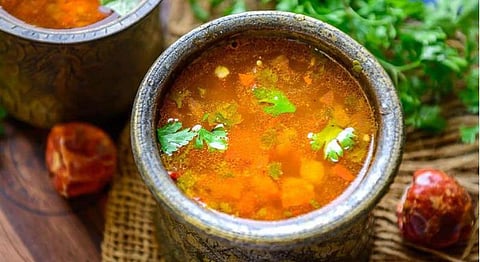
- HOMEGROWN WORLD
- #HGCREATORS
- #HGEXPLORE
- #HGVOICES
- #HGSHOP
- CAREERS
- ABOUT US
- CONTACT US

Khichdi for some, payasam for others — there is always one dish which when scooped into a bowl warms its walls and in the process of doing so also warms your soul. Food has always held the power to bring about feelings of love and bring back fond memories. While in each region, the food we speak of may differ, the underlying sentiment remains.
In most of South India, rasam plays this role. A steaming bowl with the dark goodness in it is sure to soothe you. Widely prepared and consumed in households in Kerala, Karnataka, Andhra Pradesh, and Tamil Nadu, rasam is an all-time favourite. But how did this hug-in-a-bowl come to be?
In the 16th Century in Madurai, after the Vijayanagar empire fell, the Saurashtra empire’s rule was established. They were not natives of the Temple City, or even from the southern region of India, and began as an immigrant community. They prepared a broth-like soup with tamarind pulp (rasam’s main ingredient) and pepper, both of which are abundantly found in South India. In Tamil, rasam refers to extract, and in Sanskrit, ‘rasa’ refers to juice. These similar meanings are the probable roots for the word rasam. With the addition of tomatoes, curry leaves, and lime, the soup evolved. According to famous food historian, KT Achaya, someone whose work we turn to often, the British took to rasam and referred to it as ‘mulligatawny’ –– from the Tamil words milagu meaning pepper, and thanni meaning water.
There also exists a belief that it was a particular chef in Madurai, Karunas, who invented rasam. The story goes that the King’s son had taken ill and would barely eat anything, so the King declared a prize for anyone who could come up with a dish that the son would eat. Karunas is believed to have concocted rasam for the son to cope with the illness, which is also why rasam is believed to be the go-to dish when sick.
Rich in anti-oxidants, rasam is also known to be helpful with colds in addition to circulatory and digestive issues. Ingredients such as ginger, garlic, asafoetida, fenugreek, mustard, and more lend the dish these ‘recovery’ qualities.
A few dishes have earned this precious spot in our homes and hearts over the years, and rasam has been one of them for decades. It is almost as if the entirety of South India places its trust in the flavourful soup to make their days better and their nights more comfortable. When food has the power to do so, its history and origins become all the more important, in ways more than one.
If you enjoyed reading this, we suggest you also read:
